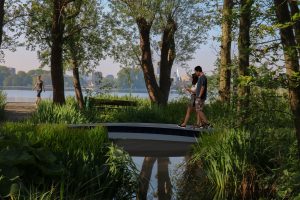
DSM partners to build 3D-printed composite footbridge
Canadian Plastics
3D Printing MaterialsThe footbridge, to be installed in Rotterdam, the Netherlands, will be made from a fibre reinforced thermoplastic called Arnite, which DSM says combines high performance with circularity.

Concept art of what the 3D-printed bridge being built in Rotterdam will look like. Construction is set to finish by the end of 2020. Image Credit: DSM.
Simon and Garfunkel famously paired up in the 1960s to sing about a bridge over troubled water.
Fast forward to today and engineering firm Royal HaskoningDHV and Dutch materials supplier DSM are collaborating in the design and construction of something not too dissimilar: a new 3D-printed, circular composite footbridge which will be installed in Rotterdam, the Netherlands.
The footbridge will be made from a fibre reinforced thermoplastic (FRP) called Arnite, which DSM says combines high performance with circularity. Sensors could also be included into the footbridge to build a digital twin of the bridge. The sensors can predict and optimize maintenance, ensuring safety and extending the lifespan of the bridge.
The city of Rotterdam infrastructure experts in composite bridges will be closely involved in the design and build process, DSM said, and the footbridge is expected to be installed and in use by the end of 2020.
The 3D-printed FRP footbridge as a circular composite aligns with Rotterdam’s ambitious sustainability targets to reduce carbon footprint and promote liveability, and Rotterdam will be the first city to test, print, and install it.
Rotterdam city officials see the use of composite bridges as a smart solution to replace older constructions. With more than 1,000 bridges in Rotterdam, the city is constantly looking to push the boundaries to develop the next generation of bridges which will be more sustainable and circular with lower maintenance and lifecycle costs.
“The printed circular composite bridge enables the transition to a more sustainable and circular type of bridges with minimal wear and tear,” said Patrick Duis, senior application development specialist, additive manufacturing at DSM. “Now that we have the new circular composite of recyclable source material along with the required performance properties available to us, we can start taking the environment-friendly design of the infrastructure to the next level.”
